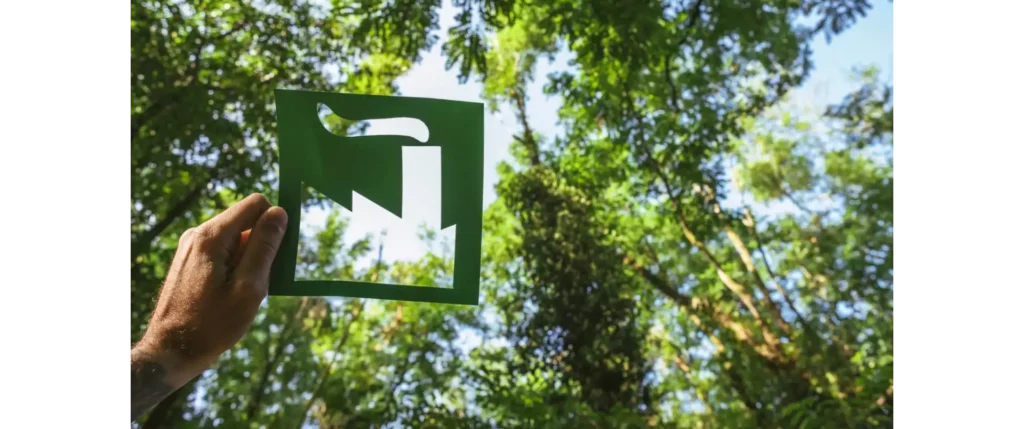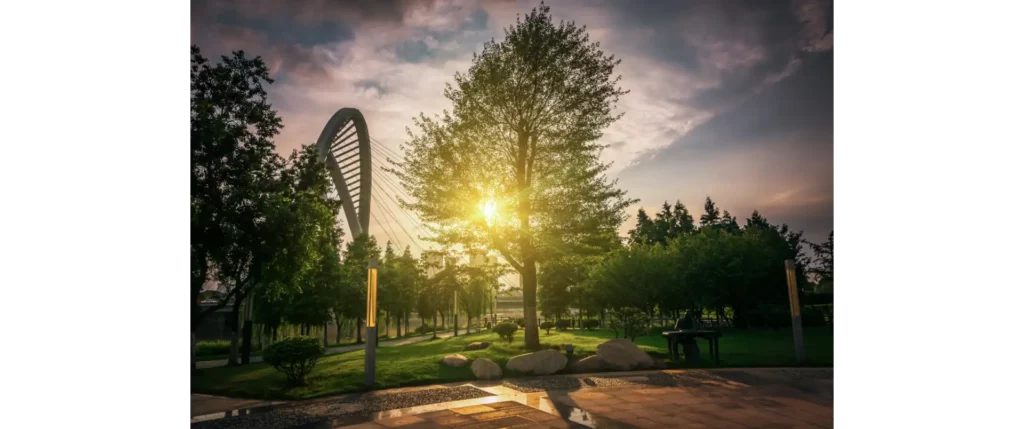Eco-Friendly Destinations
If you're seeking an adventure that aligns with your eco-conscious values, consider immersing yourself in the unique experience of a green energy park.
This destination stands as a testament to sustainability, seamlessly blending artistic expression with environmental responsibility.
As you wander through the park, you'll discover an array of artists in residence, each committed to eco-friendly practices. Among them is Judy McManus, a renowned glass artist with over 10 years of experience.
Judy's work, characterized by mesmerizing swirls of color, is not only visually captivating but also crafted with a strong emphasis on environmental sustainability.
The park also features a gallery where you can admire the eco-inspired artworks.
Beyond the visual arts, the park offers enlightening tours that showcase its sustainable energy initiatives and eco-friendly infrastructure, making it an ideal destination for those passionate about both art and the environment.
Understanding Eco-Friendly Travel
Eco-friendly travel, also known as sustainable or responsible travel, refers to a conscious effort to minimize the negative impact of tourism on the environment and local communities.
This form of travel emphasizes practices that preserve natural resources, support local economies, and promote cultural awareness.
Eco-friendly travel goes beyond simply enjoying beautiful landscapes; it's about leaving a positive mark on the places you visit.

How Eco-Friendly Travel Works
Eco-friendly travel operates based on a comprehensive set of principles that revolve around sustainability and responsible engagement:
- Conservation of Natural Resources: Eco-travel centers on conserving resources through progressive practices like renewable energy, water-saving systems, and wildlife protection.
- Supporting Local Communities: Sustainable travel means more than just exploring the surface. It involves supporting local communities by staying in local accommodations, dining at indigenous restaurants, and joining grassroots projects. This boosts the local economy and fosters cultural exchange.
- Minimizing Environmental Footprint: Eco-travelers strive to minimize their environmental impact by choosing eco-friendly transport, reducing plastic use, and participating in conservation activities. They are dedicated to preserving the beauty of the places they visit.
- Preservation of Cultural Heritage: Responsible travel preserves cultural heritage. Travelers as custodians value local customs, traditions, and practices, immersing themselves and contributing to enriching these cultural tapestries. It requires an open mind, appreciation for diversity, and support for initiatives that sustain the essence of visited places.
Top Eco-Friendly Destinations

1. Monarch Hill Renewable Energy Park
The Monarch Hill Renewable Energy Park in Fort Lauderdale held an Earth Day event, engaging 1,200 students in recycling pledges.
The event raised $10,000 for local elementary school PTAs and emphasized energy efficiency and recycling.
Originally called Monarch Hill to honor butterflies and pollinators, the park has a pollinator garden with 250 native plants.
It attracts 26 butterfly and moth species and is part of Waste Management's green efforts in South Florida, including sponsoring local events.
The park has a landfill that converts waste to electricity. It processes 3,500 tons of trash daily and powers 9,000 homes in Broward County.
The landfill, near Powerline and Green roads, is facing opposition due to its environmental impact. A public hearing in Plantation on April 17 will address these concerns.

2. Chelveston Renewable Energy Park
The Chelveston Renewable Energy Park in Northamptonshire, England used to be the RAF Chelveston Airfield during World War II. It was used by the US Army Air Force and RAF for bombers and military radio transmission.
The park is now one of the UK's biggest renewable energy projects, supporting the Oxford Cambridge Arc Economic Prospectus and the Green Arc agenda. It generates 185GWh of electricity and hydrogen each year, enough to power around 40,000 homes.
Chelveston Renewable Energy Park combines various renewable energy technologies.
It includes a solar PV plant, GE Renewable Energy's 25MW energy storage system, 60 MW of solar PV capacity, and 26 MW of wind power.
The park features GE 2.85 MW onshore wind turbines and a DC-coupled system for improved efficiency.
Simon Toseland manages a park with 30MW of wind energy and 60MW of solar power, enough for 15,000 homes.
The park also has a hydrogen energy plant, promoting cleaner energy in the UK.

3. Jim's Plain Renewable Energy Park
The Environment Protection Authority has approved Jim's Plain Renewable Energy Park.
The project by UPC Renewables Australia will involve building 31 wind turbines and a solar array, generating a total of 240 megawatts. Infrastructure like roads and substations will be developed, requiring public consultation.
Advancements in wind turbine tech improved efficiency and cut costs. Jim's Plain site is considering suppliers for new turbines. A transmission line will be built to distribute energy.
UPC Renewables Australia is leading the project. They are involved in renewable energy initiatives, including a park in Tasmania and solar farms in Vietnam and India. They aim to be a top renewable energy company in Southeast Asia.
In collaboration with UPC-AC Energy, the company is also developing a massive 1,000-MW renewable energy park in South Australia.
The projects at Jim's Plain and Robbins Island will cost $1.5 billion. In the first phase, Jim's Plain and half of Robbins Island will be built.
The generated electricity will be added to Tasmania's network, with approximately 40 megawatts from wind and 200 megawatts from solar power in the future.

4. Jackson County Green Energy Park
The Jackson County Green Energy Park converts landfill methane into clean energy, improving air and water quality. It benefits the local economy and environment.
The park supports local artists like Judy McManus, a glassblower who uses methane-powered furnaces.
Visitors can take tours to see artists using this eco-friendly energy source and learn about glassblowing and blacksmithing. The park also offers blacksmithing classes with a methane furnace that heats metal to over 2,000 degrees.
The Green Energy Park is an artistic hub that also has an animal shelter and dog park, adding to its community value.
It uses landfill methane to generate electricity, setting an example for sustainable practices.
The associated landfill converts gas to power, supplying electricity to thousands of homes and reducing emissions.

Where Can You Get Started?
Step 1: Thorough Research and Strategic Planning
To start your eco-friendly travel adventure, research destinations endorsed by EarthCheck or Rainforest Alliance. These certifications show their dedication to sustainable practices, benefiting nature and local communities.
Step 2: Thoughtful Selection of Accommodations
When traveling eco-friendly, choose lodgings that prioritize sustainability. Look for eco-lodges, boutique hotels, or guesthouses that use innovative technologies to reduce energy consumption. They should also have effective waste management strategies and support local communities.
Step 3: Deliberate Transportation Choices
Eco-friendly travel requires conscious transportation choices. Opt for trains, buses, or electric vehicles whenever possible. If you must fly, consider carbon offset programs to neutralize your environmental impact.
Step 4: Curated Activities and Enlightening Tours
When planning your trip, choose activities and tours that follow responsible tourism guidelines. Look for operators that prioritize ethical behavior, especially in their treatment of wildlife and habitats.
These operators also make a positive impact on local communities, enhancing the social and cultural aspects of the destinations.
Final Thoughts on Eco-Friendly Destinations
The Jackson County Green Energy Park showcases the benefits of renewable energy, notably using landfill methane for clean power generation. This approach provides economic and environmental advantages.
In addition to energy production, the park offers community-engaging activities like artist workshops and blacksmithing classes. Emerging projects such as Jim's Plain and Robbins Island renewable energy parks further emphasize the potential for significant clean energy output.
These initiatives highlight renewable energy's crucial role in addressing climate change and demonstrate its innovative application in community power solutions.
The renewable energy sector's growth, led by projects like Jackson County Green Energy Park, Jim's Plain Wind Farm, and Robbins Island Renewable Energy Park, illustrates the transformative potential of green energy in reducing emissions and providing affordable, clean power.
Ongoing innovation and investment in renewables are vital for a sustainable, cleaner future.
Source:
Literature review of renewable energy in the tourism industry

